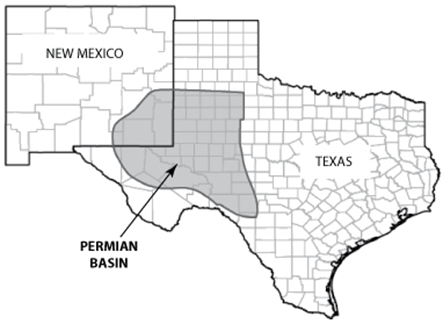The Cline Shale is a lot busier than it was six months ago.
I just returned from visiting the area with my friend Cactus Schroeder. Cactus is one of the smartest men you'll find in the oil business. He's been drilling for oil in Texas for more than 30 years... with personal interests in over 1,000 drilling projects.
Right now, Cactus is drilling like crazy in the Cline. He believes it's "one of the greatest shale areas this country has ever seen."
That's a bold statement from someone who lived in North Dakota – home to the massive Bakken Shale. He's also drilled wells in the Eagle Ford, another massive shale regions in southern Texas.
The good news for investors is this area is still well under Wall Street's radar. But I don't expect it to stay that way for long...
The Cline Shale is located in western Texas. It lies roughly 9,000 feet below the surface in an area known as the Permian Basin (shaded below). It runs about 140 miles long and 70 miles wide.

The Cline is in its early stages of development. But Special Core Analysis Labs, a reputable 24-year-old core oil-and-gas analysis firm in Texas, predicts there are 3 million barrels of oil per square mile located in the Cline. Based on the region's roughly 10,000 square miles, it could amount to a massive 30 billion barrels of oil. At current demand, that's enough oil to supply the entire U.S. for more than four years.
By comparison, the Eagle Ford has an estimated 26 billion barrels. And the Bakken Shale has roughly 13 billion barrels, according to oil-and-gas giant Pioneer Natural Resources.
This was my second visit to the Cline. On my last visit in October, most of the towns in the region had populations of less than 1,000 people. The roads were empty. Cactus and I would drive for 50 miles without seeing a single person.
Today – just eight months later – the scene has changed.
There are now several independent companies with water pits along route 180, a major highway that runs through the Cline. (Fracking a well requires millions of gallons of water – laced with sand and chemicals – shot underground to blast apart rock and retrieve oil or gas. This water is stored in open pits located near drill sites.) I also noticed dozens of billboards with ads for oil-and-gas services.
Cities like Abilene and Midland (located just outside the Cline) are becoming crowded. Cactus tells me oil-services workers are buying apartments in these areas and commuting over an hour to work. And industry insiders believe oil services giant Weatherford International is opening a huge plant in Abilene.
As we drove through these counties, we saw a lot more drilling rigs. Keep in mind, most of western Texas is desolate. The 100- to 200-foot-tall drilling rigs look like skyscrapers in the middle of a desert. And Cactus tells me this is just the beginning...
You see, the Cline is still in its early stages of development. It's not even close to what we are seeing in the Eagle Ford and Bakken in terms of the number of new homes being built. The towns that sit on top of these shales have Wal-Marts and crowded restaurants. That means business is just starting to boom in the Cline Shale region... investors can still make money as the number of major oil and gas finds in the area continues to grow...
The major players in the Cline Shale include giants Pioneer Natural Resources (PXD) and Devon Energy (DVN). Pioneer holds over 900,000 acres and Devon holds over 600,000.
Both stocks have market caps around $20 billion. However, I like Devon better than Pioneer today. The stock is trading at just 10 times forward earnings and near its 52-week low after disappointing investors last quarter. That means expectations are low. Plus, Devon is committed to drilling at least 30 new wells in the Cline this year.
Other players include oil and gas producers Apache (APA) and Range Resources (RRC). Kinder Morgan Energy Partners (KMP) is a great infrastructure play. The company is planning to build pipelines throughout the region.
These three names have much less exposure to the Cline than Devon and Pioneer. But they will see huge profits if the Cline turns out to be as big as Cactus predicts.
Good investing,
Frank Curzio
P.S. In October, I told my Small Stock Specialist subscribers about a small company that owns nearly 200,000 acres of land in the Cline Shale region. The company's valuable land holdings make it a perfect takeover target for the major producers moving into the area... The stock has triple-digit upside potential as this small, oil-rich region becomes "The Next Eagle Ford." To learn more about Small Stock Specialist – and how to access my research – click here.
No comments:
Post a Comment